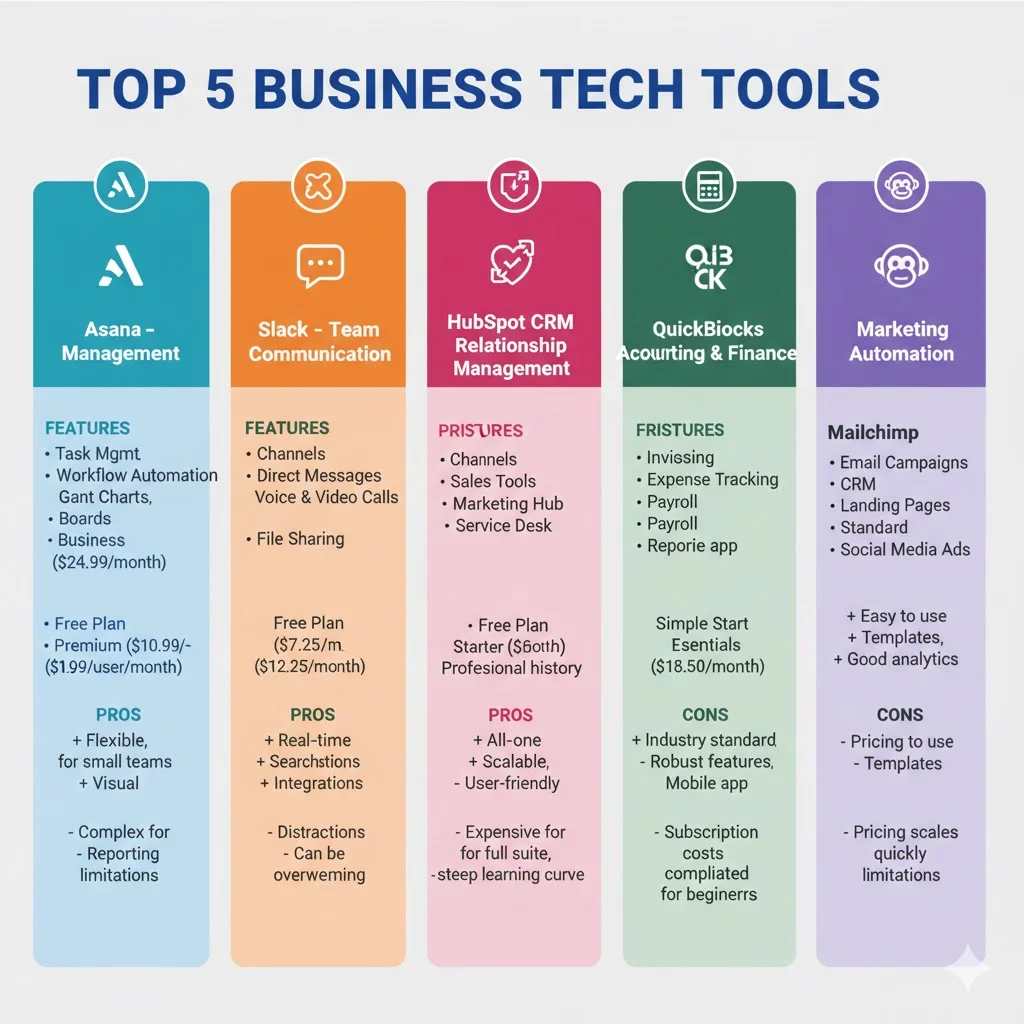Are you a business owner, startup founder, or team leader struggling to keep your operations organized, your team on the same page, or your marketing and finances running smoothly? You’re not alone. In today’s fast-paced digital world, managing a business without the right tech tools is like trying to navigate a busy city without a map—you’ll end up lost, frustrated, and wasting precious time.
That’s why in this guide, we’re diving into the top 5 tech tools for businesses in 2025 that can boost your productivity, streamline workflows, and help your team collaborate effortlessly. Whether you’re running a small startup or managing a growing enterprise, these tools are designed to make your life easier, your business smarter, and your results faster.
By the end of this article, you’ll know exactly which tools to implement, how they work, and why they’re essential for businesses like yours—so you can stop juggling chaos and start focusing on growth.
Why Businesses Need Tech Tools

Businesses today face a variety of challenges:
- Managing remote teams
- Streamlining workflows
- Tracking customer relationships
- Handling finances efficiently
- Running effective marketing campaigns
Tech tools help overcome these challenges by:
- Automating repetitive tasks
- Improving team collaboration
- Providing actionable insights from data
- Enhancing customer engagement
- Reducing human error and saving time
Example: A mid-sized marketing agency can use Asana for project management, Slack for team communication, and HubSpot CRM to track leads—creating a seamless workflow that boosts productivity by 30–40%.
How to Choose the Right Tech Tools
Before investing in software, businesses should assess their needs carefully. Consider:
- Business Goals: Are you focusing on team collaboration, customer management, or marketing automation?
- Integration Capabilities: Tools must integrate with your existing systems for smooth workflow.
- Scalability: Choose software that grows with your business.
- User-Friendliness: A complex tool may reduce adoption by your team.
- Cost-Benefit Analysis: Ensure the features justify the price.
Pro Tip: Start with a trial version to evaluate usability and ROI before committing to a paid plan.
Top 5 Tech Tools for Businesses in 2025
Here’s a detailed breakdown of the top 5 tech tools for businesses, including features, pricing, pros & cons, and real-world applications.
1. Asana – Project Management

Asana is a leading project management tool that helps teams organize, track, and manage tasks efficiently.
Key Features:
- Task assignment and tracking
- Customizable project boards and timelines
- Collaboration tools and team dashboards
- Integration with Slack, Microsoft Teams, and Google Drive
- Automation rules for repetitive tasks
Pros:
- Easy-to-use interface
- Highly customizable workflows
- Real-time collaboration
- Robust reporting and analytics
Cons:
- Can be overwhelming for small teams initially
- Advanced features require premium plan
Pricing:
- Free Plan: Up to 15 users
- Premium: $13.49/user/month
- Business: $30.49/user/month
Case Study:
A digital marketing agency using Asana increased on-time project delivery by 35% by implementing task dependencies and automated reminders.
Alternative Tools: Trello, Monday.com, ClickUp
2. Slack – Team Communication

Slack is the go-to communication platform for real-time messaging and collaboration, especially for remote teams.
Key Features:
- Channels for teams, projects, and topics
- Direct messaging and group chats
- Video and voice calls
- Integration with over 2,000 apps (Google Drive, Trello, HubSpot)
- Workflow automation with Slackbot
Pros:
- Reduces email overload
- Facilitates fast decision-making
- Supports remote and hybrid teams
- Integrates with numerous third-party apps
Cons:
- Can become cluttered with many channels
- Free plan has limited message history
Pricing:
- Free Plan: Limited features, 90-day message history
- Pro Plan: $8/user/month
- Business+: $15/user/month
Case Study:
A software development company reduced project delays by 25% using Slack for cross-department communication and daily standups.
Alternative Tools: Microsoft Teams, Zoom, Discord
3. HubSpot CRM – Customer Relationship Management

HubSpot CRM is an all-in-one platform for managing leads, automating marketing, and analyzing sales performance.
Key Features:
- Contact and lead management
- Email marketing automation
- Sales pipeline tracking
- Analytics and reporting
- Integration with websites and social media
Pros:
- Centralizes all customer data
- Easy automation of follow-ups
- Scalable for businesses of any size
- Free CRM plan available
Cons:
- Advanced marketing features can be pricey
- Learning curve for beginners
Pricing:
- Free CRM: Basic contact and lead management
- Starter: $23/month
- Professional: $890/month
- Enterprise: $3,200/month
Case Study:
An e-commerce business increased lead conversion by 20% using HubSpot’s automated workflows and email nurturing campaigns.
Alternative Tools: Salesforce, Zoho CRM, Pipedrive
4. QuickBooks – Accounting & Finance

QuickBooks simplifies financial management for businesses, from invoicing to payroll and tax reporting.
Key Features:
- Expense tracking and invoicing
- Payroll management
- Tax preparation tools
- Financial reporting and dashboards
- Integration with banks and payment gateways
Pros:
- Saves time on accounting tasks
- Reduces human error
- Supports multiple currencies
- Scalable for small to large businesses
Cons:
- Premium features can be expensive
- Can be complex for non-accountants
Pricing:
- Simple Start: $25/month
- Plus: $70/month
- Advanced: $150/month
Case Study:
A retail business automated payroll and tax filings using QuickBooks, reducing accounting errors by 40% and saving 10+ hours per week.
Alternative Tools: Xero, FreshBooks, Wave
5. Mailchimp – Marketing Automation

Mailchimp helps businesses automate email marketing and manage campaigns effectively.
Key Features:
- Email templates and automation
- Audience segmentation
- Analytics and reporting
- Social media integration
- A/B testing for campaigns
Pros:
- Easy to use for beginners
- Helps personalize marketing campaigns
- Free plan available for small businesses
- Integrates with e-commerce platforms
Cons:
- Pricing scales quickly for large lists
- Some advanced automation features are limited
Pricing:
- Free Plan: Up to 500 contacts
- Essentials: $13/month
- Standard: $20/month
- Premium: $350/month
Case Study:
An online store increased email campaign CTR by 30% using Mailchimp’s automation and personalized segmentation.
Alternative Tools: ActiveCampaign, Sendinblue, Klaviyo
Comparison Table of Top 5 Tech Tools

| Tool | Primary Use | Free Plan | Paid Plan Starts | Pros | Cons |
|---|---|---|---|---|---|
| Asana | Project Management | ✅ Yes | $13.49/user/mo | Custom workflows, collaboration | Overwhelming for small teams |
| Slack | Team Communication | ✅ Yes | $8/user/mo | Fast communication, integrations | Can become cluttered |
| HubSpot CRM | Customer Relationship Mgmt | ✅ Yes | $23/mo | Lead management, automation | Learning curve, advanced features expensive |
| QuickBooks | Accounting & Finance | ❌ No | $25/mo | Payroll, invoicing, financial reporting | Complex for non-accountants |
| Mailchimp | Marketing Automation | ✅ Yes | $13/mo | Email automation, analytics, segmentation | Pricing scales for large contacts |
Implementation Tips for Businesses
- Start Small: Implement 1–2 tools first, then scale.
- Train Your Team: Use tutorials, webinars, and guides for smooth adoption.
- Integrate Systems: Connect your CRM, project management, and communication tools.
- Track Performance: Use analytics to measure ROI and optimize usage.
- Regularly Review Tools: Update workflows and explore new features every 6–12 months.
FAQs: Top 5 Tech Tools for Businesses
1. Are these tools suitable for small businesses?
Yes, all offer scalable plans for small to large businesses.
2. Can these tools integrate with each other?
Yes, most support integrations for seamless workflows.
3. Are free versions available?
Yes, Asana, Slack, HubSpot, and Mailchimp offer free plans.
4. How do I train my team?
Leverage tutorials, webinars, and documentation provided by the platforms.
5. Which tool is best for remote teams?
Slack and Asana are highly effective for remote collaboration.
6. Can QuickBooks handle payroll?
Yes, it has built-in payroll management features.
7. Is HubSpot CRM suitable for enterprises?
Absolutely, it can manage large customer databases efficiently.
8. Does Mailchimp support social media campaigns?
Yes, it integrates and allows posting across social media.
9. Are these tools secure for business data?
Yes, all offer enterprise-level security features.
10. How often should businesses review their tools?
At least every 6–12 months to ensure optimal performance.
Conclusion
Implementing the top 5 tech tools for businesses—Asana, Slack, HubSpot CRM, QuickBooks, and Mailchimp—can transform how your business operates. From improving team collaboration to streamlining finances and marketing campaigns, these tools provide measurable ROI and scalability.
💡 Pro Tip: Start with one or two tools, integrate them with your workflow, and gradually adopt the rest to create a fully optimized digital ecosystem



